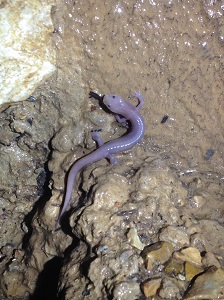at Onondaga Cave State Park
The animals that are found in caves can be separated into five groups:
Accidentals
Animals that are normally surface dwelling (epigean) and have accidentally wandered, washed or fallen into a cave. They cannot survive long in the cave environment.
Trogloxenes/Stygoxenes
Cave VisitorsAnimals that frequent caves for shelter or other favorable conditions, but must leave the caves in order to complete their life cycles. This is the largest and most diverse group of cave animals, because their food source is usually outside of the cave. Bats are an excellent example of this group. Trogloxenes are terrestrial; stygoxenes are aquatic.
Troglophiles/Stygophiles
Cave LoversAnimals that live within caves and can complete their life cycles within the caves. However, troglophiles may also be found living upon the surface in suitable habitat. The slimy salamander (Plethodon glutinosis) is a member of this group and is typically found around the entrance of Onondaga Cave. Troglophiles are terrestrial; stygophiles are aquatic.
 Troglobites/Stygobites
Troglobites/Stygobites
Cave LifeThese are animals that only live in caves or underground spring systems (hypogean) and cannot survive on the surface. These animals are uniquely adapted to the cave environment, lacking functional eyes and skin pigment. The ultraviolet light of the sun could be fatal, as could the surface temperatures and humidities. The grotto salamander (Typhlotrition speleaus) is a large troglobite that lives in Onondaga Cave. Troglobites are terrestrial; stygobites are aquatic.
Phreatobites
These are animals that live in the pore spaces of the rock. They often fall into caves with the drip water. Stygobromus onondagaensis, the Onondaga Cave amphipod, is a phreatobite. They are very small and have similar adaptations to troglobites.
Also see Food Chains and Pyramids to learn about the bat's role.






